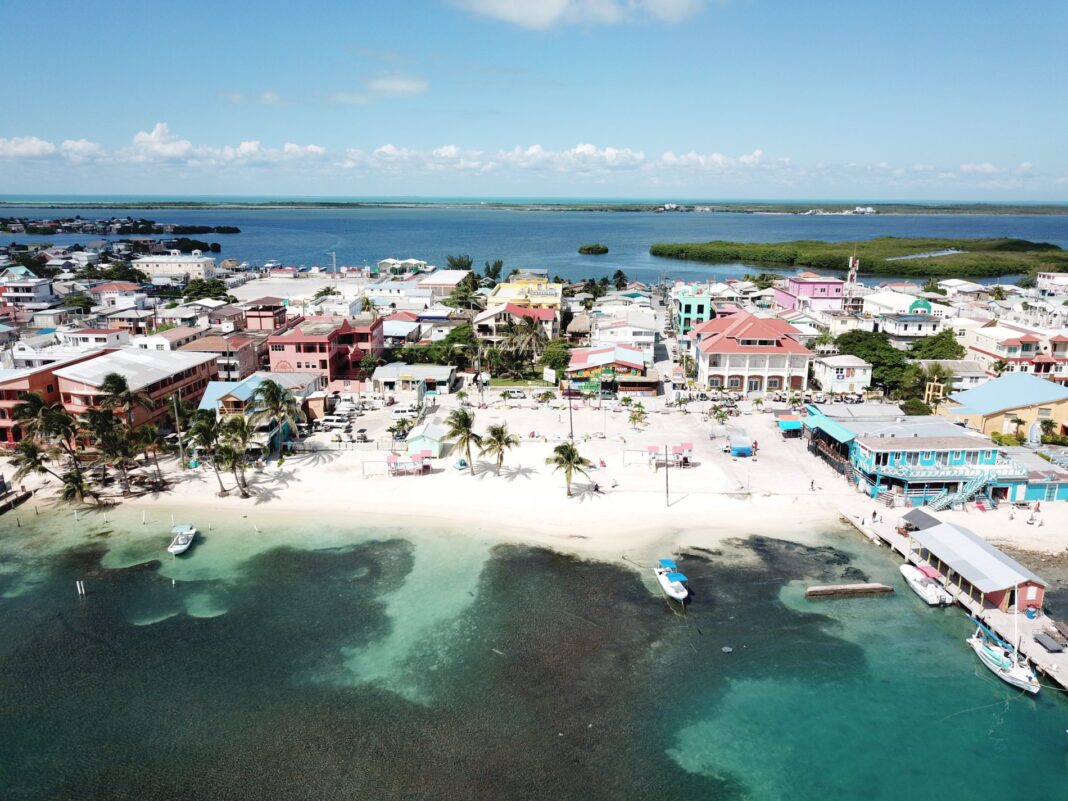The Ultimate Guide to the Safest Islands in the Caribbean for Relocating and Starting a New Life
Are you looking for a safe place to relocate and start a new life? Look no further than the Caribbean. With its tropical climate, stunning beaches, and laid-back lifestyle, it’s no wonder why so many people choose to relocate to the Caribbean. But with so many islands to choose from, it can be hard to know which one is the safest. That’s why we’ve compiled a list of the top 5 safest islands in the Caribbean for relocating and starting a new life. From beautiful beaches and lush rainforests to vibrant cities and friendly locals, these islands offer something for everyone who is looking for a safe place to settle down. So if you’re thinking about relocating or retiring in the Caribbean, read on to find out which island is right for you!
Belize, Nicaragua, Honduras, and Mexico all offer islands off their Caribbean coasts—islands that share the same turquoise-blue waters and powder-white beaches you expect when you hear “Caribbean”—only you won’t pay a fortune to live on any of them.
- Ambergris Caye, Belize
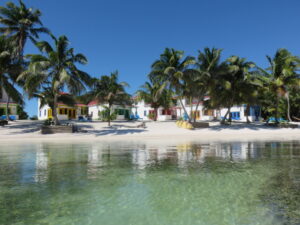 English-speaking Ambergris Caye is the largest island in Belize at 25 miles long and a little over a mile wide, and San Pedro is its only town. About 30 years ago, Ambergris became a hotspot for divers and fishermen thanks to the Belize Barrier Reef, just a half-mile offshore. This natural wonderland of living coral supports a dizzying array of marine life, and it’s the main reason Ambergris has seen its recent (and significant) growth.
English-speaking Ambergris Caye is the largest island in Belize at 25 miles long and a little over a mile wide, and San Pedro is its only town. About 30 years ago, Ambergris became a hotspot for divers and fishermen thanks to the Belize Barrier Reef, just a half-mile offshore. This natural wonderland of living coral supports a dizzying array of marine life, and it’s the main reason Ambergris has seen its recent (and significant) growth.
Until just a few years ago, San Pedro was a little fishing village that catered to adventure tourists coming for the scuba-diving and deep-sea fishing. The main motorized transportation on Ambergris Caye at that time was golf carts (which remain popular, though there are many more cars on the island today). San Pedro is now the second-largest town in Belize District with more than 15,000 people, surpassed in size only by the former capital, Belize City.
Expats give up little living on Ambergris Caye. Power, water, cell phone coverage, and internet are reliable…and you can buy most necessities for daily living on the island. Regular water taxis and flights make it easy to take a quick shopping trip in Belize City, or Chetumal, Mexico. The selection of quality restaurants and bars is constantly expanding.
For between $2,950 to $3,150 per month, a couple can enjoy a comfortable retirement in Ambergris Caye—a budget that includes the cost of a house or apartment rental. If you own your own home on the island outright, then expats report it’s possible for a couple to live quite comfortably on less than $2,000 a month.
Ambergris Caye is no longer a sleepy little Caribbean island hide away. But for expats who prefer to live in an active community that offers both convenience and the natural beauty of the surrounding Caribbean Sea, it has much to offer.
- Roatán, Honduras
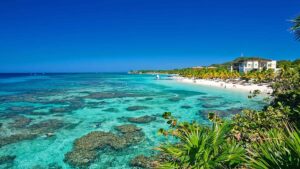 An emerald escape in the western Caribbean, Roatán has quietly graduated from secret divers’ getaway to livable island haven. Just 50 square miles, this green, hilly island off Honduras’ northern coast is long and skinny, fringed by a reef rich with sea life and garnished by white-sand beaches.The beaches here are quiet and pristine. Life is laidback, lived in rhythm with the sun and the surf. No big-name resorts. No “spring break” strips. No high-rise developments. This is old-school Caribbean…though fitted out with modern conveniences…
An emerald escape in the western Caribbean, Roatán has quietly graduated from secret divers’ getaway to livable island haven. Just 50 square miles, this green, hilly island off Honduras’ northern coast is long and skinny, fringed by a reef rich with sea life and garnished by white-sand beaches.The beaches here are quiet and pristine. Life is laidback, lived in rhythm with the sun and the surf. No big-name resorts. No “spring break” strips. No high-rise developments. This is old-school Caribbean…though fitted out with modern conveniences…
For less than $175,000, you could have a two-bedroom Caribbean home right on the water in a quiet neighborhood with no tourists—your own private getaway. If you stayed just part of the year, you could rent your place out to help cover your holding costs.
This is an island where “normal” people can buy a vacation home or permanent digs to live out their sunny, low-cost, and comfortable retirement. The infrastructure is good and getting better all the time, with a new power plant online and the recent opening of a hospital with specialist care and a 24-hour emergency room.
Life on an island is often more expensive than mainland living—almost everything has to be imported, after all. But relative to the rest of the Caribbean, Roatán offers excellent value. Daily life, lived well, is affordable on Roatán—a budget of $2,000 to $2,500 a month, all in, for an average retired couple. Cost of living always depends on lifestyle, and products imported from the U.S. are comparable to U.S. prices. But with pineapples for $2, good wine from Chile for $6 to $8 a bottle, grass-fed ground beef for $4 a pound, and $5 for a plate of grilled chicken, salad, plantains, rice, and beans at a local seaside restaurant, you can’t help but save money.
The vibrant expat community on Roatán means you’ll never be short of friends or things to do. Boating trips to nearby cays…parties, cookouts, potlucks, and other celebrations…beach barbecues (celebrating nothing other than living in paradise)…dinners out… The social life is great. And there are plenty of beach bars and restaurants.
Bottom line: Roatán is great for good-value, laidback living in the sun. Culture vultures will get bored, but if you like to dive, snorkel, swing in a hammock or sit with your feet in the sand, you’ll want to linger.
- Isla Mujeres, Mexico
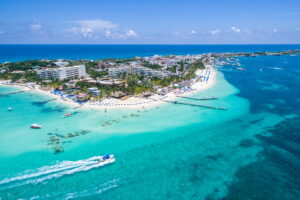 Isla Mujeres is about eight miles from Cancún in Mexico, but this laidback island is a world away from the hustle and bustle of its more tourist-developed older sister. Before Cancún existed, Mexicans and a few adventurous foreigners went to Isla Mujeres for some of the best beaches and water sports in the world—diving for coral, swimming with dolphins, and sailing on a crystal blue sea.Clear, azure waters and white-sand beaches are never far away, and the cost of living is far lower than a similar lifestyle would cost back in the States. You can own a one-bedroom, two-bathroom penthouse condo with a view from $230,000 or rent a one-bedroom place for $700 to $1000 a month, according to local expats.
Isla Mujeres is about eight miles from Cancún in Mexico, but this laidback island is a world away from the hustle and bustle of its more tourist-developed older sister. Before Cancún existed, Mexicans and a few adventurous foreigners went to Isla Mujeres for some of the best beaches and water sports in the world—diving for coral, swimming with dolphins, and sailing on a crystal blue sea.Clear, azure waters and white-sand beaches are never far away, and the cost of living is far lower than a similar lifestyle would cost back in the States. You can own a one-bedroom, two-bathroom penthouse condo with a view from $230,000 or rent a one-bedroom place for $700 to $1000 a month, according to local expats.
The island enjoys a warm tropical climate (low to mid-80s F for most of the year) and a laidback vibe; golf carts are preferred to cars as the main means of transport.
A couple can live a very nice life on Isla Mujeres for around $36,000 a year, or $2,500-$3,000 a month, including rent.
Columbus knew he was on to something good when he spotted a beautiful, coral-rimmed island in 1492. “This is the fairest land under heaven,” the explorer is reported to have said.
- Las Terrenas, Dominican Republic
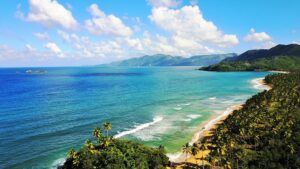 Though Columbus made many mistakes on his first voyage to the New World, he was right about the island, now known as Hispaniola, the eastern part of which is the Dominican Republic. (The western side is Haiti.) The Dominican Republic has great weather and world-class beaches, not to mention a low cost of living and a stable government—plus it’s just three-and-a-half hours from New York, which means you can leave the city in the morning and be on the beach for lunch.
Though Columbus made many mistakes on his first voyage to the New World, he was right about the island, now known as Hispaniola, the eastern part of which is the Dominican Republic. (The western side is Haiti.) The Dominican Republic has great weather and world-class beaches, not to mention a low cost of living and a stable government—plus it’s just three-and-a-half hours from New York, which means you can leave the city in the morning and be on the beach for lunch.The north coast of the island has some of the finest beaches in the Caribbean, the east coast is a sportsman’s paradise with some of the newest designer golf courses in the region.
If you’re looking for a low-key getaway but with all the conveniences of home, you’ll find the town of Las Terrenas offers excellent values with its combination of beautiful beaches, a small-town feel, chic style, and relatively affordable property. Thirty years ago, it was a rustic fishing village. Twenty-four years ago, the town didn’t have an electricity supply. But an influx of 6,000 French and Italians, who loved this place so much they decided to settle here, changed the face of the town.
Today, the town center is a whirl of motoconchos (motorcycle taxis), stores and cafés painted rainbow-bright. The original old wooden homes sitting on the beach are now trendy cafés and restaurants. They’re family-run, serving wood-fired pizza and simple snacks, right up to gourmet Italian and French food.
This isn’t all-inclusive resort territory, and thanks to strict planning laws it should stay that way. The beach hotels here are small and family-run rather than sprawling, faceless chains.
The beaches around Las Terrenas are some of the most pristine in the Dominican Republic. The most incredible thing about it, though, is the real estate prices. A one-bedroom, one-bathroom loft apartment can be had for as little as $99,500. A couple can live in this tropical haven for around $2,000 a month, although most choose to spend closer to $3,000 a month.
- Isla Colón, Panama
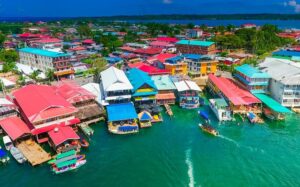 Not many people know that Panama has its own tropical archipelagos. Set on the Caribbean coast, close to the border with Costa Rica, Bocas del Toro is a group of nine main islands and a few hundred smaller cayos and islets, dotting calm turquoise waters.The main hub is bustling Bocas Town, on the large island of Isla Colon. It’s a ramshackle seaside town of brightly painted buildings—many on stilts over the water. It’s the home base for most visitors and where the majority of expats live.Bocas, as it is known, is all about water. Water sports, fishing, and whale watching are just some of the popular pastimes for locals. The small city is tourist driven but with a laidback feel.
Not many people know that Panama has its own tropical archipelagos. Set on the Caribbean coast, close to the border with Costa Rica, Bocas del Toro is a group of nine main islands and a few hundred smaller cayos and islets, dotting calm turquoise waters.The main hub is bustling Bocas Town, on the large island of Isla Colon. It’s a ramshackle seaside town of brightly painted buildings—many on stilts over the water. It’s the home base for most visitors and where the majority of expats live.Bocas, as it is known, is all about water. Water sports, fishing, and whale watching are just some of the popular pastimes for locals. The small city is tourist driven but with a laidback feel.
And you don’t need to be a millionaire to live here. You can rent a one- or two-bedroom home for as little as $600 to $1,200 a month. Including rent, your cost of living in Bocas could be as low as $2,000 a month. Bocas is home to a great deal of untitled or right of possession (ROP) property. It’s best to rent and familiarize yourself with the unique landscape before contemplating a property purchase here.
- Isla Mujeres, Mexico
- Roatán, Honduras

